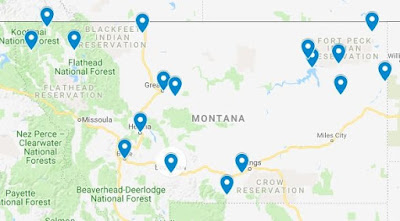by Christine Brown, Historical Specialist
In 2017, MHS launched ExploreBig.org—a website and mobile app—to share the history and architectural significance of selected Montana buildings, neighborhoods, and cultural sites listed in the National Register of Historic Places. Initially, ExploreBig included approximately 250 individual stories and several historic district and themed tours. In January 2019, the MHS Outreach and Interpretation program began efforts to make a good thing even better by showcasing our entire treasure trove of interpretive material.

After many months, ExploreBig now has 1,700 brief stories on a dizzying array of historic sites ranging from grand business blocks, churches, and schoolhouses to railroad depots, brothels, mansions, humble homes, cabins, and industrial buildings. Thankfully we had help in this time-consuming process from a dedicated group of volunteers and students. MHS volunteer turned part-time contractor Michael Connolly assisted in uploading photos and text and creating links to digitized bibliographic sources. The project is far from complete however. Connolly continues to expand the site’s visual resources, researching and adding historic images from the MHS Photo Archives and State Historic Preservation Office collections, while MHS volunteer Joe Furshong is scanning photographs from National Register of Historic Places records and contributing contemporary photographs from his travels around the state.

Watch for the launch of Historic Montana in 2020.
Students have also been key players in expanding the project. In September, Carroll College intern Augustus Krier-Ness and seven graduate students in a University of Montana public history course started work to add at least ten new themed tours to the site. And most recently, the Butte High School History Club has agreed to capture new photographs of buildings with National Register signs in the Butte National Historic Landmark, about 250 properties. Pairing new photos with historic Butte photos collected from the MHS Photo Archives and the Butte-Silver Bow Public Archives will create a striking “then and now” virtual tour of Butte’s unparalleled collection of historic buildings.

second floor of the museum. Rendering by Wyatt Design.
The next step in ExploreBig’s transformation is a new name and look and a physical exhibit inside the Montana Historical Society building. The website and app will be renamed Historic Montana and have a new address, HistoricMT.org. The makeover clearly defines the site as Montana’s go-to place to learn about historic Montana buildings and places. The exhibit, near the Society’s second-floor Research Center, will provide a dedicated touchscreen tablet for visitors and researchers to use during their visit.
Work on Historic Montana will continue long after the name change becomes part of history. MHS historians create about fifty to a hundred new National Register signs every year and the content of each one will be added to the site along with photographs and links to research sources. It’s hard to say if the site will ever be complete, but the ongoing process is well worth the time to make this information readily available. Historic Montana will be an invaluable tool for students and teachers, researchers, and curious travelers delving into place-based Montana history for years to come.































